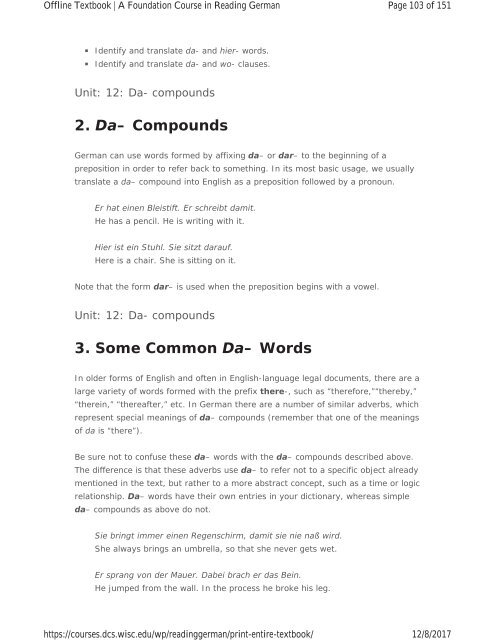A Foundation Course in Reading German, 2017a
A Foundation Course in Reading German, 2017a
A Foundation Course in Reading German, 2017a
Create successful ePaper yourself
Turn your PDF publications into a flip-book with our unique Google optimized e-Paper software.
Offl<strong>in</strong>e Textbook | A <strong>Foundation</strong> <strong>Course</strong> <strong>in</strong> Read<strong>in</strong>g <strong>German</strong><br />
https://courses.dcs.wisc.edu/wp/read<strong>in</strong>ggerman/pr<strong>in</strong>t-entire-textbook/<br />
Page 103 of 151<br />
12/8/2017<br />
Identify and translate da- and hier- words.<br />
Identify and translate da- and wo- clauses.<br />
Unit: 12: Da- compounds<br />
2. Da– Compounds<br />
<strong>German</strong> can use words formed by affix<strong>in</strong>g da– or dar– to the beg<strong>in</strong>n<strong>in</strong>g of a<br />
preposition <strong>in</strong> order to refer back to someth<strong>in</strong>g. In its most basic usage, we usually<br />
translate a da– compound <strong>in</strong>to English as a preposition followed by a pronoun.<br />
Er hat e<strong>in</strong>en Bleistift. Er schreibt damit.<br />
He has a pencil. He is writ<strong>in</strong>g with it.<br />
Hier ist e<strong>in</strong> Stuhl. Sie sitzt darauf.<br />
Here is a chair. She is sitt<strong>in</strong>g on it.<br />
Note that the form dar– is used when the preposition beg<strong>in</strong>s with a vowel.<br />
Unit: 12: Da- compounds<br />
3. Some Common Da– Words<br />
In older forms of English and often <strong>in</strong> English-language legal documents, there are a<br />
large variety of words formed with the prefix there-, such as “therefore,”“thereby,”<br />
“there<strong>in</strong>,” “thereafter,” etc. In <strong>German</strong> there are a number of similar adverbs, which<br />
represent special mean<strong>in</strong>gs of da– compounds (remember that one of the mean<strong>in</strong>gs<br />
of da is “there”).<br />
Be sure not to confuse these da– words with the da– compounds described above.<br />
The difference is that these adverbs use da– to refer not to a specific object already<br />
mentioned <strong>in</strong> the text, but rather to a more abstract concept, such as a time or logic<br />
relationship. Da– words have their own entries <strong>in</strong> your dictionary, whereas simple<br />
da– compounds as above do not.<br />
Sie br<strong>in</strong>gt immer e<strong>in</strong>en Regenschirm, damit sie nie naß wird.<br />
She always br<strong>in</strong>gs an umbrella, so that she never gets wet.<br />
Er sprang von der Mauer. Dabei brach er das Be<strong>in</strong>.<br />
He jumped from the wall. In the process he broke his leg.


















